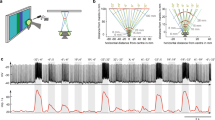Summary
Boas, pythons and pit vipers are known to use the heat radiated by warmblooded animals in order to hunt them. However, until now no comparative study to determine at what range these remarkable sense organs operate has been attempted.
The results from a comparative electrophysiological study on central infrared sensitive neurons in the tecta mesencephali ofBoa constrictor, Python reticulatus andAgkistrodon rhodostoma are used to calculate thresholds and the associated maximal detection ranges. A discussion of the rationale behind radiation physics and its implications for the calculation of thresholds and the translation into a behavioural context is given.
The thresholds determined forBoa, Python andAgkistrodon are respectively: 42.28, 14.28 and 2.57 10−6 cal/cm2·s which, in biological terms, is equivalent to that which is required to detect a mouse (10 °C warmer than the surrounding, radiating area 25 cm2) at a distance of 16.4 cm, 28.3 cm and 66.6 cm.
Similar content being viewed by others
Abbreviations
- LTTD :
-
nucleus descendons lateralis nervi trigemini
References
Bullock TH, Barret R (1968) Radiant heat reception in snakes. Comm Behav Biol 1:19–29
Bullock TH, Diecke FPJ (1956) Properties of an infrared receptor. J Physiol (London) 134:47–87
Chernov SA (1957) Systematic position of the poisonous snakeAncistrodon rhodostoma (Boie) (Serpentes, Crotalidae) in connection with its craniology. Zool Zhur 36:790–792
Cock Buning T de (1983) Thermal sensitivity as a specialization for prey capture and feeding in snakes. Am Zool (in press)
Cock Buning T de, Goris RC, Terashima S (1981a) The role of thermosensitivity in the feeding behavior of the pit viperAgkistrodon blomhofi brevicaudus. Jpn J Herpetol 9:7–27
Cock Buning T de, Poelmann RE, Dullemeijer P (1978) Feeding behaviour and the morphology of the thermoreceptors inPython reticulatus. Neth J Zool 28:62–93
Cock Buning T de, Terashima S, Goris RC (1981b) Crotaline pit organs analysed as warm receptors. Cell Mol Neurobiol 1:69–85
Cock Buning T de, Terashima S, Goris RC (1981c)Python pit organs analyzed as warm receptors. Cell Mol Neurobiol 1:271–278
Düring M von, Miller MR (1979) Sensory nerve endings of the skin and deeper structures. In: Gans C, Parsons TS (eds) Biology of the reptilia, vol 9. Academic Press, London, pp 407–450
Goris RC, Nomoto M (1967) Infrared reception in oriental crotaline snakes. Comp Biochem Physiol 23:879–892
Goris RC, Terashima S (1973) Central response to infrared stimulation of the pit receptors in a Crotaline snake,Trimeresurus flavoviridis. J Exp Biol 58:59–76
Gruberg ER, Kiclitter E, Newmann EA, Kass L, Hartline PH (1979) Connections of the tectum of the rattlesnakeCrotalus viridis: an HRP study. J Comp Neurol 183:31–42
Harris JF, Gamow RI (1971) Snake infrared receptors: thermal or photochemical mechanism? Science 172:1252–1253
Hartline PH (1974) Thermoreception in snakes. In: Fessard A (ed) Handbook of sensory physiology, vol 3. Springer, Berlin Heidelberg New York, pp 297–312
Hartline PH, Kass L, Loop MS (1978) Merging of modalities in the optic tectum: infared and visual integration in rattlesnakes. Science 199:1225–1229
Haseltine EC (1978) Infrared and visual organization of the tectum in Boid snakes. Ph.D. Thesis, Indiana University
Hensel H (1975) Static and dynamic activity of warm receptors inBoa constrictor. Pflügers Arch 353:181–199
Kishida R, Amemya F, Kusonoki T, Terashima S (1980) A new tectal afferent nucleus of the infrared sensory system in the medulla oblongata of Crotaline snakes. Brain Res 195:271–279
Klauber LM (1972) Rattlesnakes, their habits, life histories, and influence on mankind, vol 1, 2. University of California Press, Berkley Los Angeles
Kürten L, Schmidt U (1982) Thermoreception in the common vampire bat (Desmodus rotundus). J Comp Physiol 146:223–228
Molenaar GJ (1974) An additional trigeminal system in certain snakes possessing infrared receptors. Brain Res 78:340–344
Molenaar GJ, Fizaan-Oostveen JLFP (1980) Ascending projections from the lateral descending and common sensory trigeminal nuclei inPython. J Comp Neurol 189:555–572
Newman EA, Gruberg ER, Hartline PH (1980) The infrared trigemino-tectal pathway in the rattlesnake and in thePython. J Comp Neurol 191:465–477
Newman EA, Hartline PH (1981) Integration of visual and infrared information in bimodal neurons of the rattlesnake optic tectum. Science 213:789–791
Noble GK, Schmidt A (1937) The structure and function of the facial and labial pits of snakes. Proc Am Philos Soc 77:263–288
Schroeder DM, Loop MS (1976) Trigeminal projections in snakes possessing infrared sensitivity. J Comp Neurol 169:1–14
Tanaka H, Mishima S, Abe Y (1967) Studies on the behavior ofTrimeresurus flavoviridis (Hallowell 1860), a venomous snake, on Amami Oshima island in regard to speed of movement, nocturnal activity and sensitivity to infra-red radiation. Bull Tokyo Med Dent Univ 14:79–104
Terashima S (1980) A heat-sensing mechanism: A study of an infrared organ. Shizen 35:64–74 (in Japanese)
Terashima S, Goris RC (1975) Tectal organization of pit viper infrared reception. Brain Res 83:490–494
Terashima S, Goris RC, Katsuki Y (1968) Generator potential of Crotaline snake infrared receptor. J Neurophysiol 31:682–688
Author information
Authors and Affiliations
Additional information
Recently, it became commonly accepted under taxonomists to renameAgkistrodon rhodostoma on systematical grounds toCalloselasma rhodostoma (Chernov 1957). However, the author prefers to use, in this physiologically and behaviourally oriented paper, the better known old name
Rights and permissions
About this article
Cite this article
de Cock Buning, T. Thresholds of infrared sensitive tectal neurons inPython reticulatus, Boa constrictor andAgkistrodon rhodostoma . J. Comp. Physiol. 151, 461–467 (1983). https://doi.org/10.1007/BF00605462
Accepted:
Issue Date:
DOI: https://doi.org/10.1007/BF00605462




